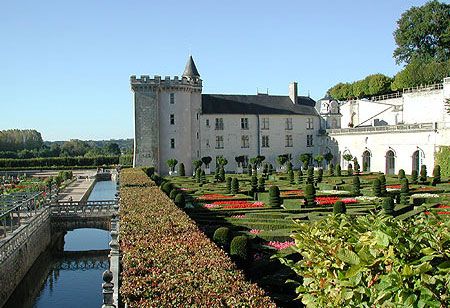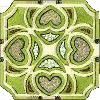Gardens of Villandry Castle


Villandry was completed toward 1536 and was the last of the large chateaux built on the banks of the Loire during the Renaissance. The castle was built by Jean le Breton, one of Francois I's Finance Ministers. His most impressive achievement in this field was the construction of Chambord, that vast flight of regal fancy, which Le Breton supervised under the aegis of Francois I. While directing this project, he built for himself nearby a small replica of Villandry called Villesavin near the Chambord chateau. Le Breton had first been ambassador to Italy where he spent all his time studying the Italian Renaissance art of gardenning. In order to build the present chateau, Le Breton had razed an old 12th century castle , from which he had only kept the old tower that can be seen behind the main courtyard.
Villandry stayed in le Breton's family until 1754 and then became the property of the Marquis de Castellane, the King's Ambassador who came from a very illustrious noble family from Provence. He built the Classical style outbuildings that you can see on either side of the front courtyard. He redesigned the interior of the chateau to meet the standards of comfort of the XVIIIth century which are much closer to those we know today than to those, which were applied during the Renaissance.
The traditional gardens were destroyed in the 19th century to create an English-style park around the chateau (in the style of Monceau park in Paris).
In 1906 the chateau was bought by Dr Joachim Carvallo, who was born in Spain in 1869, and who is the great-grandfather of the present owners. He gave up a brilliant scientific career with Professor Charles Richet, the winner of the Nobel Prize in 1913, to devote himself entirely to Villandry. He thus saved the chateau which was just about to be demolished and created the presentday gardens which are in complete harmony with the Renaissance architecture of the chateau. In 1924 Joachim Carvallo also founded the "Demeure Historique", which was the first association for people owning chateaux of historical value. He was a pioneer in the opening of this kind of historic buildings to the public.
|
|
|
1. The Giftshop 5. The Maze |
The love garden
The ornamental gardens above the kitchen garden are an extension of the rooms of the chateau. To have an overall view of the whole garden you have to go up to the belvedere. The first four squares just in front represent an allegory of the "Gardens of Love". Each clump evokes one of the following four feelings of love: tender love with hearts and masks formed by edges of boxwood, passionate love with bleeding hearts, fickle love with clumps shaped like horns and fans, and tragic love with knife blades. Inside each clump, the specific choice of both the flowers and their individual colors was intended to emphasize the power of the feeling of love in question. Orange was for tenderness, red for tragedy, yellow for adultery. Much to our delight, the geometric ensemble is perfectly completed by two fountains marking the intersection of the paths.

 |
a. "Tender Love" is symbolized by hearts separated by the flames of love in the corners. In the centre are the domino masks are situated in the centre. They were worn at balls which allowed all types of conversations, from the most serious to the most frivolous. |
 |
b. "Passionate Love" is also represented by the same hearts but this time, they are broken by passion. The box hedges are criss-crossed and form a maze, which also constitutes an evocation of dance. |
 |
c. "Fickle Love" The four fans in the corners symbolize the volatile nature of feelings. The horns of the jilted lover are situated between these fans and the love letters or "billets doux" that the fickle lady sent to her lover are in the centre. The dominant colourin this square is yellow, the colour of jilted love. |
 |
d. "Tragic Love" the design represents the blades of daggers and swords used during the duels that were provoked by lovers' rivalry. In summer, flowers are red to symbolize the blood spilt during these fights. |
|
The water garden |
 |
|
|
|
The Maze
A hedgerow maze has recently been opened. It is based on the pattern of the Renaissance.
The herb garden
The herb garden is situated between the Kitchen garden and the Church, like in all gardens in the Middle Ages. It is dedicated to aromatic, cooking and medicinal herbs. The garden here contains some thirty varieties of these beneficial plants which were considered to be essential for family life by our ancestors.
The vegetable garden
Between the Chateau and the village is the Renaissance vegetable garden. It has nine squares of equal size but with different geometrical patterns.
|
|
|
These squares are planted with vegetables of contrasting colours (the blue of the leek, the red of the cabbage and beetroot, the jade green of the carrot tops), which gives the impression of a multicoloured chequer-board. The vegetable garden was created in the Middle Ages. The monks in their Abbeys took great pleasure in growing their vegetables in geometrical patterns. Much later, the pragmatic Doctor Carvallo had recreated the vegetable garden during WWI to feed his hospitalized patients. This was his favorite garden, laid out over 9 completely different squares with a clever mix of 250,000 vegetable and flower plants that have only a decorative purpose today, but one of very high design. Nine gardeners oversee the care and regular replacement of all the plants in order to preserve the color harmony during all growing seasons. Autumn is the best time of year to admire the crimson color of the decorative cabbages.
The many crosses in the Villandry kitchen garden remind us of these monastic origins. The monks also planted standard roses to decorate their gardens. According to a long-standing tradition, the roses here are planted symmetrically, representing the monk working his vegetable patch.
The second influence came from Italy and inspired the ornamental features in this monastic garden: the fountains, bowers and flower beds.
French XVIth century gardeners combined both the French and the Italian monastic inspirations to create the garden which they needed for the roses and vegetables newly arrived from America. They called it the "ornamental kitchen garden". Their work was described by Androuet du Cerceau and constituted the inspiration for Joachim Carvallo when he designed the kitchen garden.
|
The music garden |
|
chateauvillandry.com
Articole asemănătoare
-
Ienibaharul, piperul cu o suta de arome
Ienibaharul este un arbore tropical din familia myrtaceae cu flori si fructe dispuse in ciorchini. Prima descriere in literatura a acestui arbore a fost facuta de naturalistul Patrick Browne in anul 1755, in cartea sa "The Civil and Natural History of Jamaica".
-
Gradinile de la Villandry, Franta
Gradinile de la Villandry sunt cele mai renumite si spectaculoase dintre toate care se intalnesc pe valea fluviului Loire.
-
Plantele decorative de interior si sanatatea
Cercetari stiintifice asupra plantelor si substantelor toxice au demonstrat capacitatea unor plante de a micsora efectul toxic al unor substante prezente adesea in interiorul locuintelor si in mediile industriale. Studiul a fost facut in SUA de catre Asociatia ALCA - Associated Landscape Contractors of America.
-
Andrographis paniculata
Andrographis paniculata este o planta ce se utilizeaza in medicina Ayurvedica, fiind cunoscuta si sub alte nume precum Green Chiretta, Kalmegh, Maha-Tita (King of Bitters). Andrographis paniculata este un arbust din Asia, cu flori albe si violet.
-
The Garden of Cosmic Speculation, Scotia
Scotia este recunoscuta ca avand unele din gradinile cele mai splendide din lume. Scotienii stau foarte bine si la capitolul ingeniozitate in privinta gradinilor.




